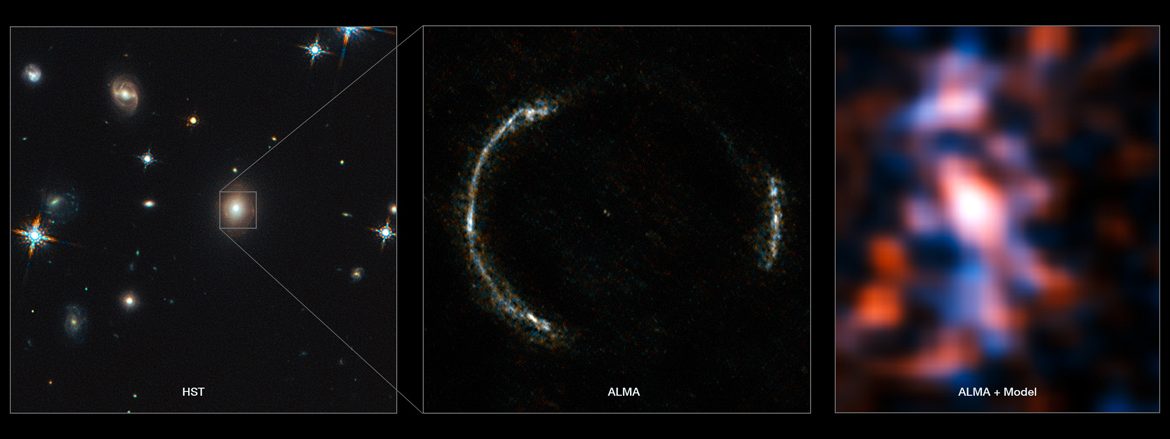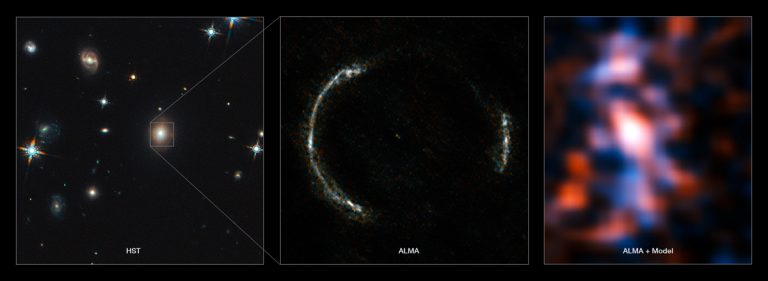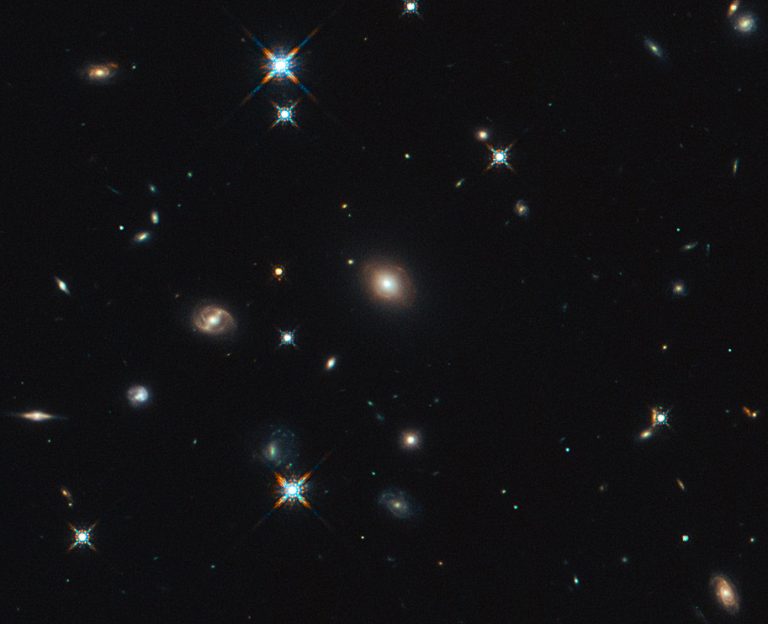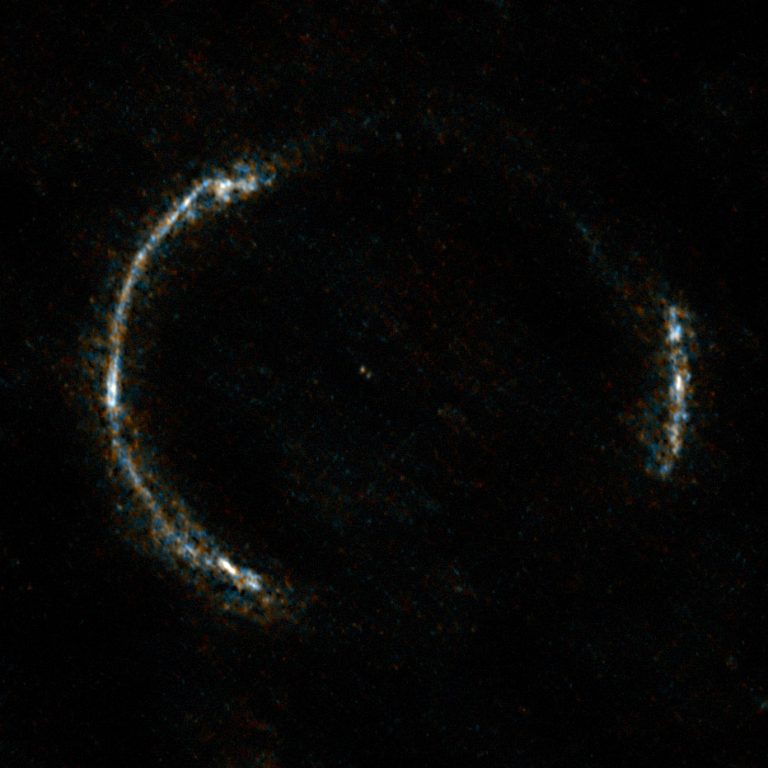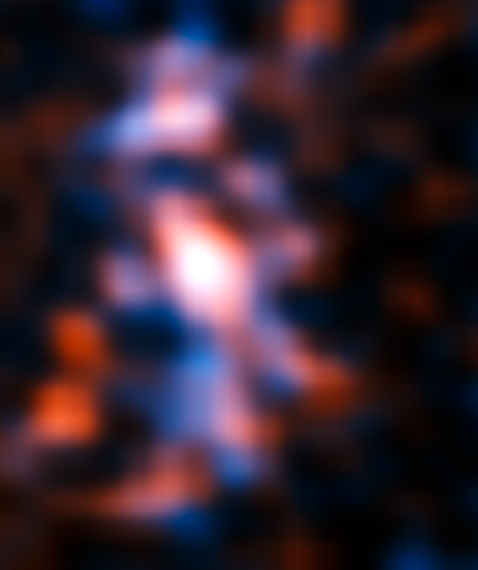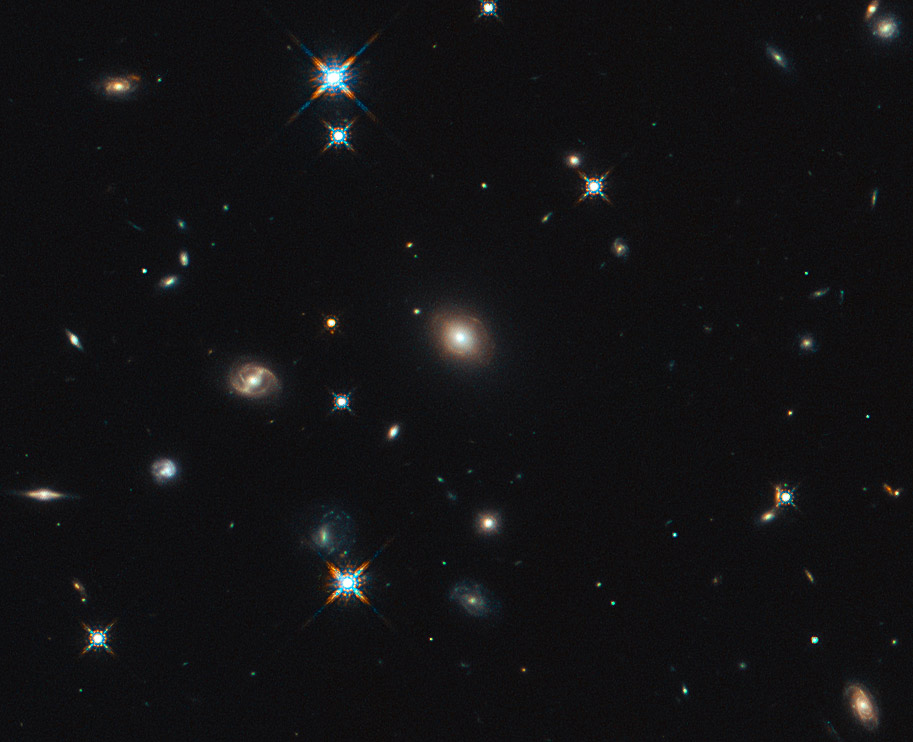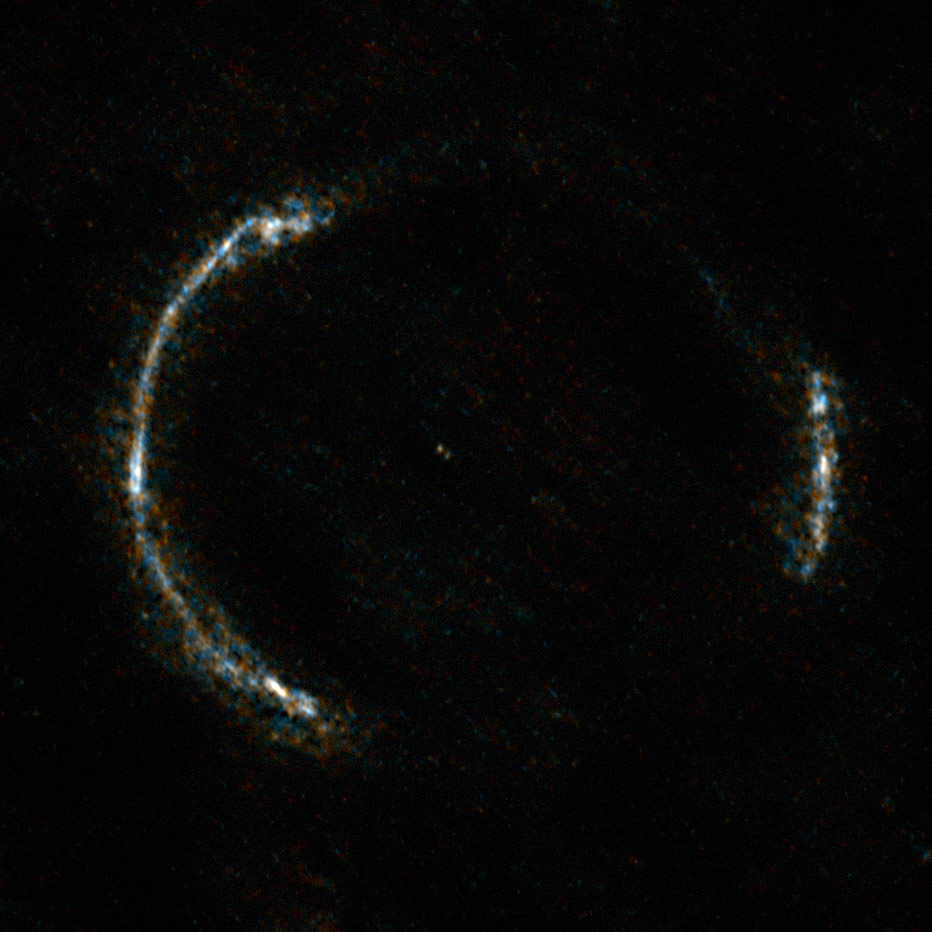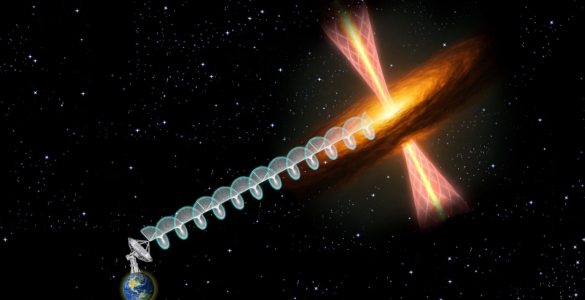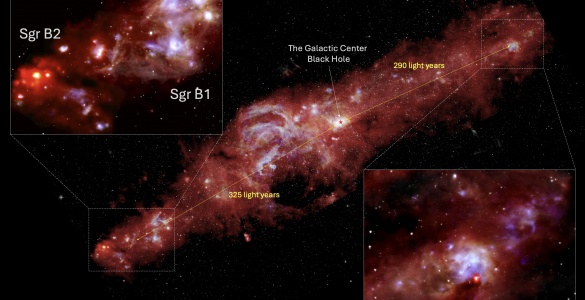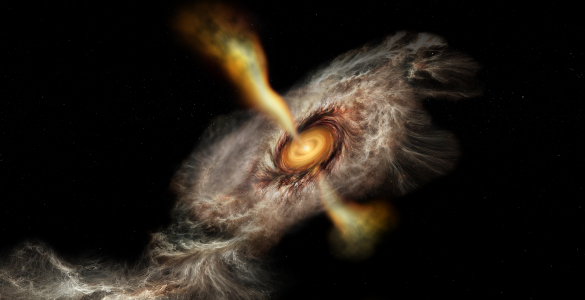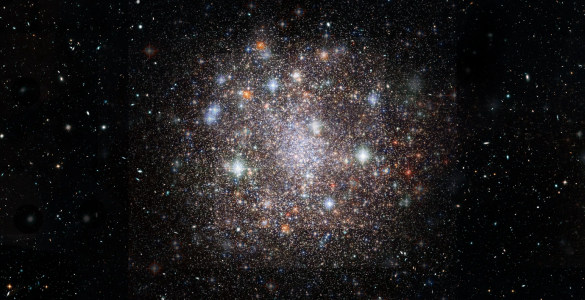ALMA’s Long Baseline Campaign produced spectacular images of the distant, gravitationally lensed galaxy called HATLAS J090311.6+003906, otherwise known as SDP.81. New analyses of these images reveal details never before seen in a galaxy so remote, including phenomenally massive yet concentrated clumps of star-forming material.
The ALMA observations of SDP.81, made at the end of 2014, were enabled by a cosmic effect known as gravitational lensing. A large galaxy nestled between SDP.81 and ALMA [1] is acting as a lens, magnifying the more distant galaxy’s light and warping it into a near-perfect example of a phenomenon known as an Einstein Ring [2].
In the months following these observations, at least seven groups of scientists [3] have independently analyzed the ALMA data on SDP.81. This flurry of research papers has divulged unprecedented information about the galaxy, including details about its structure, contents, motion, and other physical characteristics.
Since ALMA is an interferometer — a single instrument made up of multiple antennas — it can adjust its resolution by repositioning its antennas. During this observing campaign, ALMA’s antennas were at their greatest separation – up to 15 kilometers apart – providing the highest resolution ever achieved by the telescope. As a result, these new images of SDP.81 have a resolution up to six times greater [4] than those taken in the infrared with the NASA/ESA Hubble Space Telescope.
By using sophisticated models to correct for the distortion produced by the magnifying gravitational lens, the astronomers were able to reveal fine, never-before-seen structure within SDP.81 in the form of dusty clouds thought to be giant repositories of cold molecular gas — the birthplaces of stars and planets.
As a result, the ALMA observations are so sharp that researchers can see clumps of star formation in the galaxy down to a size of about 200 light-years. This is the first time this phenomenon has been seen at such an enormous distance.
“ALMA was designed to be the most powerful telescope of its kind, but by harnessing the magnifying power of this gravitational lens we were able to study a distant and mysterious object in detail that would have been impossible otherwise,” said Todd Hunter, an astronomer at the National Radio Astronomy Observatory and co-author on one of the papers. “This one dataset has spawned an entire series of highly intriguing research, confirming that ALMA offers the astronomical community new avenues to probe the distant Universe.”
“The reconstructed ALMA image of the galaxy is spectacular,” says Rob Ivison, co-author of two of the papers and ESO’s Director for Science. “ALMA’s huge collecting area, the large separation of its antennas, and the stable atmosphere above the Atacama Desert all lead to exquisite detail in both images and spectra. That means that we get very sensitive observations, as well as information about how the different parts of the galaxy are moving. We can study galaxies at the other end of the Universe as they merge and create huge numbers of stars. This is the kind of stuff that gets me up in the morning!”
Using the spectral information gathered by ALMA, astronomers also measured how the distant galaxy rotates and estimated its mass. The data show that the gas in this galaxy is unstable; clumps of it are collapsing inward and will likely turn into new giant star-forming regions in the future.
Notably, the modeling of the lensing effect also indicates the existence of a supermassive black hole at the center of the foreground galaxy lens [5]. The central part of SDP.81 is too faint to be detected, leading to the conclusion that the foreground galaxy holds a supermassive black hole more than 200–300 million times the mass of the Sun.
The number of papers published using this single ALMA dataset demonstrates the excitement generated by the potential of the array’s high resolution and light-gathering power. It also shows how ALMA will enable astronomers to make more discoveries in the years to come, also uncovering yet more questions about the nature of distant galaxies.
# # #
The National Radio Astronomy Observatory is a facility of the National Science Foundation, operated under cooperative agreement by Associated Universities, Inc.
The Atacama Large Millimeter/submillimeter Array (ALMA), an international astronomy facility, is a partnership of ESO, the US National Science Foundation (NSF) and the National Institutes of Natural Sciences (NINS) of Japan in cooperation with the Republic of Chile. ALMA is funded by ESO on behalf of its Member States, by NSF in cooperation with the National Research Council of Canada (NRC) and the National Science Council of Taiwan (NSC) and by NINS in cooperation with the Academia Sinica (AS) in Taiwan and the Korea Astronomy and Space Science Institute (KASI).
ALMA construction and operations are led by ESO on behalf of its Member States; by the National Radio Astronomy Observatory (NRAO), managed by Associated Universities, Inc. (AUI), on behalf of North America; and by the National Astronomical Observatory of Japan (NAOJ) on behalf of East Asia. The Joint ALMA Observatory (JAO) provides the unified leadership and management of the construction, commissioning and operation of ALMA.
[1] The lensed galaxy is seen at a time when the Universe was only 15 percent of its current age, just 2.4 billion years after Big Bang. The light has taken over twice the age of the Earth to reach us (11.4 billion years), detouring along the way around a massive foreground galaxy that is comparatively close at 4 billion light-years away from us.
[2] Gravitational lenses were predicted by Albert Einstein as part of his theory of general relativity. His theory tells us that objects bend space and time. Any light approaching this curved space-time will itself follow the curvatures created by the object. This enables particularly massive objects — huge galaxies and galaxy clusters — to act as cosmic magnifying glasses. An Einstein Ring is a special type of gravitational lens, in which the Earth, the foreground lensing galaxy, and the background lensed galaxy are in perfect alignment, creating a harmonious distortion in the form of a ring of light. This phenomenon is illustrated in the accompanying video.
[3] The science teams are listed below.
[4] Details down to 0.023 arcseconds, or 23 milliarcseconds, can be measured in these data. Hubble observed this galaxy in the near-infrared, with a resolution of about 0.16 arcseconds. Note, however, that when observing at shorter wavelengths, Hubble can reach finer resolutions, down to 0.022 arcseconds in the near-ultraviolet. ALMA’s resolution can be adjusted depending on the type of observations by moving the antennas further apart or closer together. For these observations, the widest separation was used, resulting in ALMA’s finest resolution possible at these wavelengths.
[5] The high-resolution ALMA image enables researchers to look for the central part of the background galaxy, which is expected to appear at the center of the Einstein ring. If the foreground galaxy has a supermassive black hole at the center, the central image becomes fainter. The faintness of the central image indicates how massive the black hole in the foreground galaxy is.
More information
This research was presented in eight papers to appear in the near future. The science teams are listed below:
http://arxiv.org/abs/1503.07605
Yoichi Tamura (The University of Tokyo), Masamune Oguri (The University of Tokyo), Daisuke Iono (National Astronomical Observatory of Japan/SOKENDAI), Bunyo Hats
ukade (National Astronomical Observatory of Japan), Yuichi Matsuda (National Astronomical Observatory of Japan/SOKENDAI), and Masao Hayashi (National Astronomical Observatory of Japan).
http://arxiv.org/abs/1503.08720
Simon Dye (University of Nottingham), Christina Furlanetto (University of Nottingham; CAPES Foundation, Ministry of Education of Brazil, Brazil), Mark Swinbank (Durham University), Catherine Vlahakis (Joint ALMA Observatory, Chile; ESO, Chile), James Nightingale (University of Nottingham), Loretta Dunne (University of Canterbury, New Zealand; Institute for Astronomy [IfA], Royal Observatory Edinburgh), Steve Eales (Cardiff University), Ian Smail (Durham), Ivan Oteo-Gomez (IfA, Edinburgh; ESO, Germany), Todd Hunter (National Radio Astronomy Observatory, Charlottesville, Virginia, USA), Mattia Negrello (INAF, Osservatorio Astronomico di Padova, Vicolo Osservatorio, Padova, Italy), Helmut Dannerbauer (Universitat Wien, Vienna, Austria), Rob Ivison (IfA, Edinburgh; ESO, Germany), Raphael Gavazzi (Universite Pierre et Marie Curie, Paris), Asantha Cooray (California Institute of Technology, USA) and Paul van der Werf (Leiden University, The Netherlands).
http://arxiv.org/abs/1505.05148
Mark Swinbank (Durham University), Simon Dye (University of Nottingham), James Nightingale (University of Nottingham), Christina Furlanetto (University of Nottingham; CAPES Foundation, Ministry of Education of Brazil, Brazil), Ian Smail (Durham), Asantha Cooray (California Institute of Technology, USA), Helmut Dannerbauer (Universitat Wien, Vienna, Austria), Loretta Dunne (University of Canterbury, New Zealand; Institute for Astronomy [IfA], Royal Observatory Edinburgh), Steve Eales (Cardiff University), Raphael Gavazzi (Universite Pierre et Marie Curie, Paris), Todd Hunter (National Radio Astronomy Observatory, Charlottesville, Virginia, USA), Rob Ivison (IfA, Edinburgh; ESO, Germany), Mattia Negrello (INAF, Osservatorio Astronomico di Padova, Vicolo Osservatorio, Padova, Italy), Ivan Oteo-Gomez (IfA, Edinburgh; ESO, Germany), Renske Smit (Durham), Paul van der Werf (Leiden University, The Netherlands), and Catherine Vlahakis (Joint ALMA Observatory, Chile; ESO, Chile).
http://arxiv.org/abs/1503.05558
Kenneth C. Wong (Institute of Astronomy and Astrophysics, Academia Sinica (ASIAA), Taipei, Taiwan), Sherry H. Suyu (ASIAA, Taiwan), and Satoki Matsushita (ASIAA, Taiwan)
http://arxiv.org/abs/1503.07997
Bunyo Hatsukade (National Astronomical Observatory of Japan, Tokyo, Japan) Yoichi Tamura (Institute of Astronomy, University of Tokyo, Tokyo, Japan), Daisuke Iono (National Astronomical Observatory of Japan; The Graduate University for Advanced Studies [SOKENDAI], Tokyo, Japan), Yuichi Matsuda (National Astronomical Observatory of Japan), Masao Hayashi (National Astronomical Observatory of Japan), Masamune Oguri (Research Center for the Early Universe, University of Tokyo, Tokyo, Japan; Department of Physics, University of Tokyo, Tokyo, Japan; Kavli Institute for the Physics and Mathematics of the Universe [Kavli IPMU, WPI], University of Tokyo, Chiba, Japan)
http://arxiv.org/abs/1503.02652
The ALMA Partnership, C. Vlahakis (Joint ALMA Observatory [JAO]; ESO) , T. R. Hunter (National Radio Astronomy Observatory [NRAO]), J. A. Hodge (NRAO) , L. M. Pérez (NRAO) , P. Andreani (ESO), C. L. Brogan (NRAO) , P. Cox (JAO, ESO) , S. Martin (Institut de Radioastronomie Millimétrique [IRAM]) , M. Zwaan (ESO) , S. Matsushita (Institute of Astronomy and Astrophysic, Taiwan) , W. R. F. Dent (JAO, ESO), C. M. V. Impellizzeri (JAO, NRAO), E. B. Fomalont (JAO, NRAO), Y. Asaki (National Astronomical Observatory of Japan; Institute of Space and Astronautical Science (ISAS), Japan Aerospace Exploration Agency [JAXA]) , D. Barkats (JAO, ESO) , R. E. Hills (Astrophysics Group, Cavendish Laboratory), A. Hirota (JAO; National Astronomical Observatory of Japan), R. Kneissl (JAO, ESO), E. Liuzzo (INAF, Istituto di Radioastronomia), R. Lucas (Institut de Planétologie et d’Astrophysique de Grenoble) , N. Marcelino (INAF), K. Nakanishi (JAO, National Astronomical Observatory of Japan), N. Phillips (JAO, ESO), A. M. S. Richards (University of Manchester), I. Toledo (JAO), R. Aladro (ESO), D. Broguiere (IRAM), J. R. Cortes (JAO, NRAO), P. C. Cortes (JAO, NRAO), D. Espada (ESO, National Astronomical Observatory of Japan), F. Galarza (JAO), D. Garcia-Appadoo (JAO, ESO), L. Guzman-Ramirez (ESO), A. S. Hales (JAO, NRAO) , E. M. Humphreys (ESO) , T. Jung (Korea Astronomy and Space Science Institute) , S. Kameno (JAO, National Astronomical Observatory of Japan) , R. A. Laing (ESO), S. Leon (JAO,ESO) , G. Marconi (JAO, ESO) , A. Mignano (INAF) , B. Nikolic (Astrophysics Group, Cavendish Laboratory), L. A. Nyman (JAO, ESO), M. Radiszcz (JAO), A. Remijan (JAO, NRAO), J. A. Rodón (ESO), T. Sawada (JAO, National Astronomical Observatory of Japan), S. Takahashi (JAO, National Astronomical Observatory of Japan), R. P. J. Tilanus (Leiden University), B. Vila Vilaro (JAO, ESO), L. C. Watson (ESO), T. Wiklind (JAO, ESO), Y. Ao (National Astronomical Observatory of Japan) , J. Di Francesco (National Research Council Herzberg Astronomy & Astrophysics), B. Hatsukade (National Astronomical Observatory of Japan), E. Hatziminaoglou (ESO), J. Mangum (NRAO), Y. Matsuda (National Astronomical Observatory of Japan), E. Van Kampen (ESO), A. Wootten (NRAO), I. De Gregorio-Monsalvo (JAO, ESO), G. Dumas (IRAM), H. Francke (JAO), J. Gallardo (JAO), J. Garcia (JAO), S. Gonzalez (JAO), T. Hill (ESO), D. Iono (National Astronomical Observatory of Japan), T. Kaminski (ESO), A. Karim (Argelander-Institute for Astronomy), M. Krips (IRAM), Y. Kurono (JAO, National Astronomical Observatory of Japan) , C. Lonsdale (NRAO), C. Lopez (JAO), F. Morales (JAO), K. Plarre (JAO), L. Videla (JAO), E. Villard (JAO, ESO), J. E. Hibbard (NRAO), K. Tatematsu (National Astronomical Observatory of Japan)
http://arxiv.org/abs/1503.02025
M. Rybak (Max Planck Institute for Astrophysics), J. P. McKean (Netherlands Institute for Radio Astronomy; University of Groningen) S. Vegetti (Max Planck Institute for Astrophysics), P. Andreani (ESO) and S. D. M. White (Max Planck Institute for Astrophysics)
http://arxiv.org/abs/1506.01425
M. Rybak (Max Planck Institute for Astrophysics), S. Vegetti (Max Planck Institute for Astrophysics), J. P. McKean (Netherlands Institute for Radio Astronomy; University of Groningen), P. Andreani (ESO) and S. D. M. White (Max Planck Institute for Astrophysics)
Research papers accepted for publication or in press.
http://arxiv.org/abs/1503.07605 [Accepted for publication in Publications of the Astronomical Society of Japan]
http://arxiv.org/abs/1505.05148 [In press Astrophysical Journal, Letters]
http://arxiv.org/abs/1503.02652 [Accepted for publication in Astrophysical Journal, Letters]
http://arxiv.org/abs/1503.02025 [Accepted for publication in Monthly Notices of the Royal Astronomical Society]
Research papers posted prior to journal acceptance:
http://arxiv.org/abs/1503.08720
http://arxiv.org/abs/1503.05558
http://arxiv.org/abs/1503.07997
http://arxiv.org/abs/1506.01425
Contact: Charles Blue, Public Information Officer
(434) 296-0314; cblue@nrao.edu






